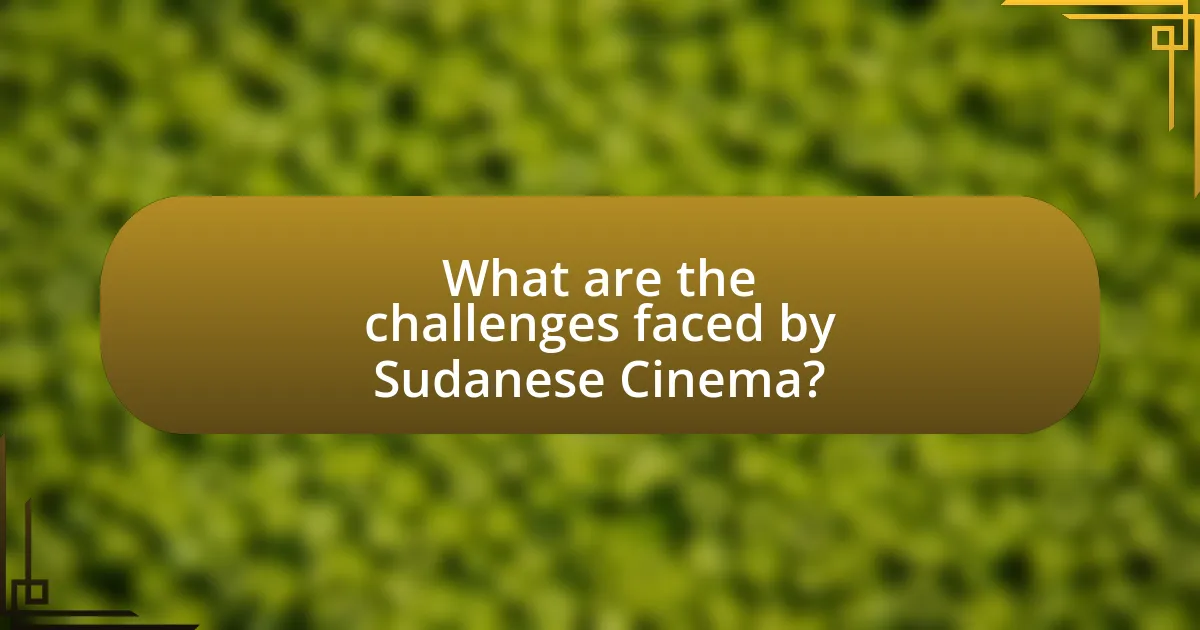Sudanese cinema is the film industry in Sudan, known for its storytelling that reflects the country’s diverse culture and social issues. The article explores the evolution of Sudanese cinema from its early beginnings to its current state, highlighting key milestones, prevalent themes, and the impact of historical events on film production. It discusses the challenges faced by filmmakers, including censorship and funding limitations, while also emphasizing the opportunities for growth through international collaboration and digital platforms. Additionally, the article examines how Sudanese cinema serves as a cultural exchange tool, promoting understanding and dialogue between different cultures, and provides insights into how audiences can engage with and support this emerging film industry.

What is Sudanese Cinema?
Sudanese cinema refers to the film industry in Sudan, characterized by its unique storytelling that reflects the country’s diverse culture and social issues. Emerging in the early 20th century, Sudanese cinema gained international recognition with films like “The Last Flight” (1987) and “You Will Die at Twenty” (2019), which address themes of identity, conflict, and resilience. The industry has faced challenges, including censorship and limited funding, but continues to evolve, showcasing Sudan’s rich heritage and fostering cultural exchange through film festivals and collaborations with international filmmakers.
How has Sudanese Cinema evolved over the years?
Sudanese cinema has evolved significantly over the years, transitioning from early silent films in the 1920s to a more diverse and vibrant film industry today. Initially, Sudanese cinema was limited in scope and production, with few films being made until the 1960s, when the first feature films emerged, reflecting social and political themes relevant to Sudanese society. The 1980s and 1990s saw a decline due to political instability and censorship, but the 2000s marked a resurgence, with filmmakers like Hajooj Kuka gaining international recognition for their work. This evolution is evidenced by the increasing number of film festivals in Sudan and abroad, showcasing Sudanese films and promoting cultural exchange, such as the Sudan Independent Film Festival established in 2015.
What historical events have influenced Sudanese Cinema?
Sudanese cinema has been significantly influenced by historical events such as the British-Egyptian colonization (1899-1956), the independence of Sudan in 1956, and the subsequent civil wars. The colonization period introduced Western film techniques and narratives, which shaped early Sudanese filmmakers. Following independence, the establishment of the Sudanese Film Unit in 1962 marked a pivotal moment, as it aimed to promote national identity through cinema. The civil wars, particularly from the 1980s onward, led to a focus on themes of conflict and displacement in films, reflecting the socio-political struggles of the nation. These events collectively shaped the evolution of Sudanese cinema, influencing its themes, styles, and the role of film as a medium for cultural expression and social commentary.
What are the key milestones in the development of Sudanese films?
The key milestones in the development of Sudanese films include the establishment of the Sudanese Film Unit in 1962, which marked the beginning of organized film production in the country. In 1970, the first feature film, “The Night of Counting the Years,” directed by Shadi Abdel Salam, gained international recognition, showcasing Sudanese storytelling. The 1980s saw the emergence of independent filmmakers, with works like “The Last of the Pharaohs” highlighting Sudan’s cultural narratives. The 2000s brought a resurgence in filmmaking, exemplified by the film “Teza” by Haile Gerima, which received critical acclaim and contributed to the global visibility of Sudanese cinema. These milestones collectively reflect the evolution and cultural significance of film in Sudan.
What themes are prevalent in Sudanese Cinema?
Prevalent themes in Sudanese cinema include identity, social justice, and the impact of conflict. These themes reflect the country’s complex history and cultural dynamics. For instance, films often explore the struggles of individuals and communities in the face of political turmoil and social inequality, highlighting the quest for personal and national identity. Additionally, the representation of women’s experiences and their roles in society is a significant focus, showcasing both challenges and resilience. This thematic exploration is evident in works like “You Will Die at Twenty,” which addresses the effects of war and the search for meaning in life amidst adversity.
How do cultural narratives shape the storytelling in Sudanese films?
Cultural narratives significantly shape the storytelling in Sudanese films by reflecting the country’s diverse history, traditions, and social issues. These narratives often incorporate elements of Sudanese folklore, historical events, and contemporary societal challenges, allowing filmmakers to convey messages that resonate with local audiences. For instance, films like “You Will Die at Twenty” explore themes of fate and identity, rooted in Sudanese cultural beliefs and experiences. This integration of cultural narratives not only enhances the authenticity of the storytelling but also fosters a sense of national identity and unity among viewers, as they see their own stories and struggles represented on screen.
What social issues are commonly addressed in Sudanese Cinema?
Sudanese cinema commonly addresses social issues such as gender inequality, conflict, displacement, and cultural identity. Films often depict the struggles of women in patriarchal societies, highlighting their fight for rights and representation. Additionally, the impact of civil wars and political instability is frequently portrayed, showcasing the experiences of displaced individuals and communities. Cultural identity is also a significant theme, as filmmakers explore the complexities of Sudanese heritage and the effects of globalization. These themes reflect the broader societal challenges faced in Sudan, making cinema a vital medium for social commentary and cultural expression.
How does Sudanese Cinema serve as a cultural exchange tool?
Sudanese cinema serves as a cultural exchange tool by showcasing the diverse narratives and experiences of Sudanese society, thereby fostering understanding and dialogue between different cultures. Films produced in Sudan often address social issues, historical events, and cultural traditions, which resonate with both local and international audiences. For instance, the film “You Will Die at Twenty,” which premiered at the Venice Film Festival, highlights themes of fate and identity, allowing viewers from various backgrounds to engage with Sudanese culture on a deeper level. This engagement promotes cross-cultural dialogue and enhances global awareness of Sudan’s rich heritage and contemporary challenges.
What role do film festivals play in promoting Sudanese Cinema internationally?
Film festivals play a crucial role in promoting Sudanese cinema internationally by providing a platform for filmmakers to showcase their work to global audiences. These festivals facilitate networking opportunities, allowing Sudanese filmmakers to connect with international industry professionals, which can lead to collaborations and distribution deals. For instance, the Sudanese film “You Will Die at Twenty” gained international recognition after being screened at the Venice Film Festival in 2019, highlighting the potential for Sudanese narratives to reach wider audiences. Additionally, film festivals often include panels and discussions that educate attendees about Sudanese culture and social issues, further enhancing the visibility and appreciation of Sudanese cinema on a global scale.
How do collaborations with foreign filmmakers enhance cultural exchange?
Collaborations with foreign filmmakers enhance cultural exchange by facilitating the sharing of diverse narratives and artistic techniques. These partnerships allow filmmakers from different backgrounds to combine their unique perspectives, resulting in films that reflect a blend of cultural elements. For instance, Sudanese filmmakers collaborating with international counterparts can introduce local stories and traditions to a global audience, while also gaining insights into different filmmaking styles and storytelling methods. This exchange not only broadens the filmmakers’ creative horizons but also fosters mutual understanding and appreciation among audiences, as evidenced by successful co-productions that have garnered international acclaim, such as “The Last Days of the Man of Tomorrow,” which showcases Sudanese culture through a collaborative lens.

What are the challenges faced by Sudanese Cinema?
Sudanese cinema faces significant challenges, including limited funding, censorship, and a lack of infrastructure. The financial constraints hinder filmmakers from producing high-quality films, while censorship restricts creative expression and the exploration of sensitive topics. Additionally, inadequate infrastructure, such as insufficient theaters and distribution networks, limits audience access to Sudanese films. These factors collectively impede the growth and visibility of Sudanese cinema on both national and international stages.
How do political and economic factors impact film production in Sudan?
Political and economic factors significantly impact film production in Sudan by influencing funding availability, regulatory environments, and creative freedom. The political instability and conflict in Sudan have led to a lack of government support and investment in the arts, resulting in limited financial resources for filmmakers. For instance, the Sudanese film industry has struggled to secure funding from both local and international sources due to concerns over censorship and the political climate. Additionally, economic challenges, such as inflation and limited access to markets, further constrain production capabilities, making it difficult for filmmakers to produce and distribute their work effectively. These factors collectively hinder the growth and sustainability of the film industry in Sudan, affecting its ability to serve as a cultural exchange tool.
What restrictions do filmmakers face in Sudan?
Filmmakers in Sudan face significant restrictions, primarily due to government censorship and regulatory hurdles. The Sudanese government imposes strict controls over film content, requiring filmmakers to obtain permits that often involve extensive scrutiny of scripts and final products. Additionally, filmmakers encounter limitations on topics deemed sensitive, such as political dissent, religion, and social issues, which can lead to self-censorship. The lack of funding and resources further complicates the filmmaking process, as many projects struggle to secure financial backing in a challenging economic environment. These restrictions hinder the growth and expression of Sudanese cinema, impacting its potential as a cultural exchange tool.
How does funding affect the quality and quantity of films produced?
Funding directly influences both the quality and quantity of films produced, as it determines the resources available for production, marketing, and distribution. Higher funding allows filmmakers to access better technology, hire skilled professionals, and invest in comprehensive marketing strategies, which collectively enhance the overall production quality. For instance, films with budgets exceeding $1 million often exhibit superior cinematography and sound design compared to lower-budget films, as evidenced by the success of films like “The Last Black Man in San Francisco,” which had a budget of $1.5 million and received critical acclaim for its production values. Conversely, limited funding restricts the number of films that can be produced, as seen in regions with fewer financial resources, where filmmakers may struggle to complete projects or may have to compromise on quality due to budget constraints. Thus, funding is a critical determinant in shaping the landscape of film production, particularly in contexts like Sudanese cinema, where financial support can significantly impact cultural representation and exchange.
What are the opportunities for growth in Sudanese Cinema?
Opportunities for growth in Sudanese cinema include increased international collaboration, access to digital platforms, and a growing interest in diverse narratives. International collaboration can enhance production quality and broaden distribution channels, as evidenced by Sudanese filmmakers participating in global film festivals and co-productions. Access to digital platforms allows for wider audience reach, with streaming services increasingly showcasing Sudanese films, thus providing financial viability. Additionally, the rising interest in authentic and diverse narratives presents a unique opportunity for Sudanese filmmakers to tell their stories, as seen in the success of films like “You Will Die at Twenty,” which gained international acclaim and highlighted Sudanese culture.
How can technology improve film distribution in Sudan?
Technology can improve film distribution in Sudan by enabling digital platforms that facilitate wider access to films. These platforms, such as streaming services and mobile applications, allow filmmakers to reach audiences directly, bypassing traditional distribution barriers. For instance, the rise of internet penetration in Sudan, which reached approximately 50% in 2023, supports the feasibility of online distribution. Additionally, social media can be leveraged for marketing and audience engagement, enhancing visibility for Sudanese films. The use of digital payment systems can also streamline transactions, making it easier for consumers to purchase or rent films.
What potential exists for Sudanese films in global markets?
Sudanese films have significant potential in global markets due to their unique storytelling and cultural perspectives. The increasing interest in diverse narratives and the global demand for authentic representations of different cultures create opportunities for Sudanese filmmakers to reach wider audiences. For instance, the success of films like “You Will Die at Twenty,” which premiered at the Venice Film Festival, highlights the international recognition and appreciation of Sudanese cinema. Additionally, platforms like Netflix are expanding their content to include films from underrepresented regions, further enhancing the visibility of Sudanese films. This trend indicates a growing market for Sudanese narratives that resonate with global audiences, driven by a desire for cultural exchange and understanding.

How can audiences engage with Sudanese Cinema?
Audiences can engage with Sudanese cinema by attending film screenings, participating in film festivals, and accessing online platforms that showcase Sudanese films. Film screenings often occur in cultural centers and universities, providing opportunities for viewers to experience Sudanese storytelling and artistry firsthand. Additionally, film festivals, such as the Sudanese Film Festival, highlight local filmmakers and encourage audience interaction through Q&A sessions and discussions. Online platforms, including streaming services and social media, allow global audiences to discover and share Sudanese films, fostering a broader appreciation for the cultural narratives presented in this cinema.
What platforms are available for viewing Sudanese films?
Several platforms are available for viewing Sudanese films, including Netflix, YouTube, and specialized streaming services like Sudanese Film Festival’s online platform. Netflix has featured Sudanese films such as “You Will Die at Twenty,” which gained international recognition. YouTube hosts a variety of Sudanese short films and documentaries, making them accessible to a global audience. Additionally, the Sudanese Film Festival’s online platform showcases a curated selection of films, promoting Sudanese cinema and culture.
How can streaming services contribute to the visibility of Sudanese Cinema?
Streaming services can significantly enhance the visibility of Sudanese Cinema by providing a global platform for distribution and audience engagement. These platforms allow Sudanese films to reach international viewers who may not have access to traditional cinema outlets, thereby expanding the audience base. For instance, Netflix has invested in African content, including Sudanese films, which increases exposure and recognition. Additionally, streaming services often feature curated collections that highlight regional cinema, further promoting Sudanese filmmakers and their stories. This accessibility not only fosters cultural exchange but also encourages investment and collaboration in the Sudanese film industry, as seen with the rise of co-productions and partnerships with international filmmakers.
What role do social media and online communities play in promoting Sudanese films?
Social media and online communities significantly enhance the visibility and reach of Sudanese films. These platforms allow filmmakers to share trailers, behind-the-scenes content, and engage directly with audiences, fostering a sense of community and support. For instance, the use of Facebook and Instagram has enabled Sudanese filmmakers to connect with both local and international viewers, leading to increased attendance at screenings and festivals. Additionally, online communities often facilitate discussions and reviews that can elevate a film’s profile, as seen with the success of films like “You Will Die at Twenty,” which gained international recognition partly through social media buzz.
What are some recommended Sudanese films to watch?
Some recommended Sudanese films to watch include “You Will Die at Twenty,” “The Last Days of the Man of Letters,” and “Tajouj.” “You Will Die at Twenty,” directed by Amjad Abu Alala, won the Best First Film award at the Venice Film Festival in 2019, showcasing Sudanese storytelling. “The Last Days of the Man of Letters,” directed by Mohamed Kordofani, explores themes of identity and belonging, while “Tajouj,” directed by Suhaib Gasmelbari, highlights the struggles of women in Sudan. These films reflect the rich cultural narratives and social issues within Sudanese society.
Which films best represent the cultural narratives of Sudan?
The films that best represent the cultural narratives of Sudan include “The Last Days of the Man of Letters,” “You Will Die at Twenty,” and “Tajouj.” These films explore themes of identity, conflict, and resilience within Sudanese society. “The Last Days of the Man of Letters,” directed by the Sudanese filmmaker, focuses on the struggles of intellectuals in a changing society, reflecting the historical context of Sudan’s political landscape. “You Will Die at Twenty,” directed by Amjad Abu Alala, portrays the impact of prophecy and fate on a young man’s life, resonating with Sudanese cultural beliefs. “Tajouj,” directed by Sudanese filmmaker, highlights the experiences of women in Sudan, addressing gender issues and societal expectations. Each of these films provides insight into the complexities of Sudanese culture and the narratives that shape its identity.
How can viewers support Sudanese filmmakers and the industry?
Viewers can support Sudanese filmmakers and the industry by actively engaging with their films through attendance at screenings, purchasing or streaming their content, and promoting their work on social media platforms. Engaging with Sudanese films directly contributes to their financial success and visibility, which is crucial for the growth of the industry. For instance, the Sudanese film “You Will Die at Twenty” gained international recognition and support through festival screenings, illustrating how viewer participation can elevate a film’s profile and encourage further production.

Leave a Reply